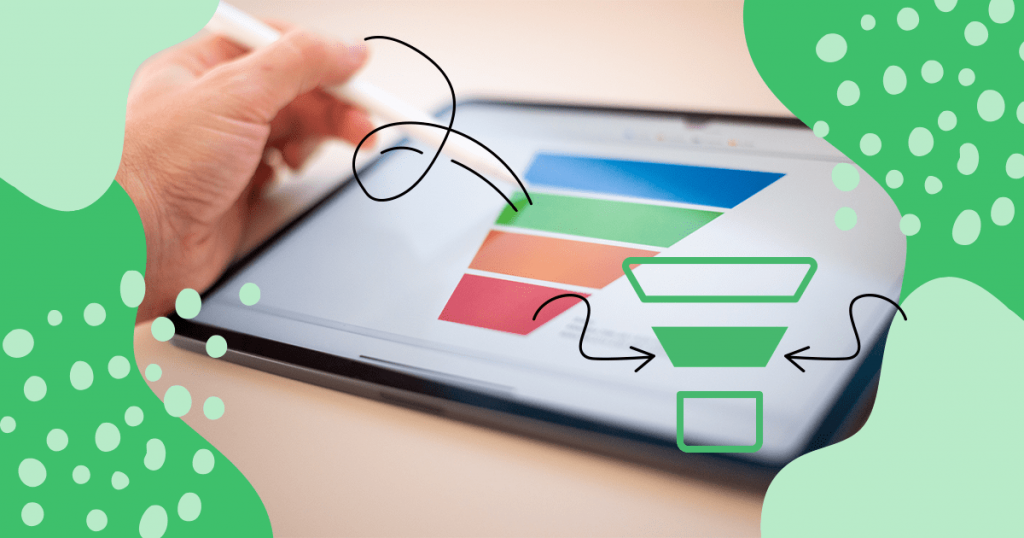Understanding the digital marketing funnel is an important part of being a modern marketer.
It is a visual representation of the process your prospects move through as they become a customer of your brand. Because of this, it helps you understand the mindsets of your buyers and where they fall in the journey.
However, oftentimes you’ll see companies put more effort into their top-of-funnel and bottom-of-funnel marketing, leaving middle-of-funnel marketing off to the side.
This is a big mistake, as each of the three steps of the marketing funnel needs equal attention in order to convert the highest number of leads into customers.
But what is middle-of-funnel marketing, and why does it matter so much to your brand when it isn’t generating new leads or closing deals?
Learn more about it in this blog.
- What is Middle-of-Funnel Marketing?
- The Importance of Middle-of-Funnel Marketing
- 6 Common Middle-of-Funnel Marketing Strategies
- Middle-of-Funnel Content Ideas
- Wrap Up
What is Middle-of-Funnel Marketing?
The marketing funnel, sometimes referred to as the sales funnel, is a tool used to help understand the buyer’s journey and the process a prospect will take before becoming a customer of your business.
There are three steps in the marketing funnel:
Top-of-funnel
Lead generation and brand awareness marketing, also called the awareness stage of the buyer’s journey.
Middle-of-funnel
Lead nurturing and educational marketing, also called the consideration stage of the buyer’s journey.
Bottom-of-funnel
Lead decision-making and closing marketing, also called the decision stage of the buyer’s journey.
The middle of the marketing funnel is the stage in which leads who are aware of your brand start moving closer to buying your products or services.
Prospects in this stage are looking for more detailed and in-depth information about your brand, so educational content is critical in this part of the buyer’s journey.
The middle of the funnel is also a great time to evaluate the needs of the prospective customer and see if they are a qualified lead that fits into your customer profile.
If they are, you can qualify the lead and pass them along to your sales team to help them move to the bottom of the funnel and become a customer.
The Importance of Middle-of-Funnel Marketing
The middle of the funnel doesn’t always seem like a valuable place to spend time to those new to the marketing funnel concept.
After all, doesn’t generating new leads and closing deals matter more than educating prospects and qualifying leads?
The answer is no. The middle of the funnel serves just as valuable of a purpose as the other steps.
Without a strategy for middle-of-funnel marketing, your leads can quickly lose interest in your brand and move on to a competitor.
It can also make the handoff between marketing and sales a misaligned and confusing mess.
Another way to think of middle-of-funnel marketing is this: while sales teams might say they want more leads, what they really mean is that they want better leads.
The middle of the funnel takes all of the interest you’ve gathered from the top of the funnel marketing and filters through to find the best, highest-quality leads to move through the process to the bottom of the funnel.
What is Lead Qualification and Nurturing?
While generating new leads is important, the next steps you take with those leads are just as critical.
Lead qualification and lead nurturing strategies help you sort through all the prospective customers you have and discover which ones are actually interested in your brand, products, or services.
Lead qualification
The process of examining prospects and leads to find out who is most likely to become a future customer of your business and gauging their interest level in your brand.
Lead nurturing
The process of guiding leads through the marketing funnel by growing your relationship with them and maintaining that valuable relationship through marketing, communication, and messaging.
6 Common Middle-of-Funnel Marketing Strategies
As mentioned above, middle-of-funnel marketing is often put to the side in favor of lead generating top-of-funnel and sale-closing bottom-of-funnel marketing tactics.
That leaves you in a poor position, however, where your leads aren’t nurtured and never learn enough about your brand to make a sale.
Here are a few best practices and middle-of-funnel marketing strategies to keep in mind as you build out your marketing funnel tactics.
1. Invest in Email Marketing
Email marketing is a great way to get your message in front of audiences and keep your brand at the top of their minds.
While you don’t want to overdo your email messaging and come across as spam, carefully curating emails can help guide leads along the marketing funnel process.
Avoid pushing too hard for a sale. After all, customers in this stage aren’t ready to make a purchase decision yet.
Instead, provide product updates, helpful blog posts or ebook links, and individualize the content as much as possible to strengthen the relationship with the prospective customer.
2. Create Detailed How-To Guides
If a lead is interested in your brand’s products or services, they want to learn more before making a full commitment to become a customer.
Detailed guides, product demos, and instructional papers help to communicate exactly what your products and services do to customers.
Not only does this provide informational and educational content, it also helps your customers feel at ease with your brand.
It cuts out unnecessary friction points or frustrations that a customer might have while researching your business.
3. Make Communication Easy and Simple
If customers in the middle of the funnel have questions or concerns, make it easy for them to find you.
A prospect shouldn’t have to make a sale in order to talk to someone at your company or get answers to their questions. Tools like chatbots, quizzes, or FAQ libraries can help your prospects avoid frustration.
By making communication easy for leads, you also strengthen your relationship with prospects and endear your brand to them.
After all, leads are more likely to buy from a brand with great customer service.
4. Examine Your CTA Structure
Calls to action, or CTAs, aren’t just random buttons and links at the bottom of blogs and website pages.
They are important tools that help provide clear next steps for customers and move them along a desired path in the customer’s journey.
The CTA structure you develop should have a clear goal in mind.
If you think that leads in the middle-of-funnel marketing step aren’t moving along as you’d hoped, then take a step back and examine your CTAs.
Do they have logical progression and take your leads closer to making a purchase? Or do they just lead a customer back around to pages that they’ve already seen?
5. Implement Lead Scoring
Lead scoring is a process that helps improve your lead qualification efforts.
By giving new leads a numerical score, you can quickly determine a prospect’s interest in your brand and the potential win rate of the lead.
You can attribute scores based on the behavior of a website visitor or lead.
Do they look at high-value pages, or do they just bounce away? Have they filled out a form or followed a social account, or have they unfollowed and unsubscribed?
By adding a score to each lead, you can help your sales team know which leads are the hottest to follow up with.
6. Improve Internal Handoff Procedures
Speaking of sales teams, they play an important role in middle-of-funnel marketing.
Creating a clear handoff process between marketing and sales can help you determine when a lead is ready to move over to the sales team and when they need more time to be nurtured.
Improving communication between sales and marketing creates a better working environment and helps avoid any potential slowdowns and friction between internal teams.
Middle-of-Funnel Content Ideas
Now that you understand some of the best practices to keep in mind as you work on middle-of-funnel marketing efforts, let’s take a closer look at some of the best content ideas and types that can help you achieve your middle-of-funnel marketing goals.
Here are some of the most effective content ideas:
- Email nurture campaigns
- Detailed videos, webinars, and infographics
- Product reviews
- Product and service demos
- In-depth ebooks and blogs
- White papers
- Industry reports
- Gated content
- Social media
- Solution website pages
Wrap Up
The marketing funnel guides many different practices in digital marketing, and it’s important that each step of the funnel gets equal attention.
The middle of your marketing funnel helps prospects learn more about your brand, supports their research, and helps nurture your leads into loyal customers.
Planning your middle-of-funnel marketing strategies requires you to understand how to set a strong foundation for your content efforts.
WriterAccess is a platform that can help you with that. Sign up for a 14-day free trial to experience the content revolution!



![[Rock NA] Sales Funnel Planner Sales Funnel Planner - Download Now](https://rockcontent.com/wp-content/uploads/2022/08/Banner-de-final-de-post-750x200-1.png)







